Will Gold Equity Investors Strike Gold?
So far in 2011 gold prices have increased [approx. 8] percent.. while the stocks of gold [mining] companies in the HUI have… declined 13%…[As such,] this year’s carnage has created a substantial opportunity to buy healthy gold mining companies at their second-cheapest level in nearly 30 years compared to gold bullion. [Let us explain.] Words: 1265
So say Frank Holmes and Ralph Aldis (www.usfunds.com) in excerpts from an article* which Lorimer Wilson, editor of www.munKNEE.com (It’s all about Money!), has further edited ([ ]), abridged (…) and reformatted below for the sake of clarity and brevity to ensure a fast and easy read. Please note that this paragraph must be included in any article re-posting to avoid copyright infringement. Holmes and Aldis go on to say:
Gold Share Performance Relative to Bullion Since 2011
The chart [below] shows gold equities of all market capitalization sizes were holding up quite well until late April when global sentiment toward equities, not just gold shares, began to waver and prices dropped off a cliff.
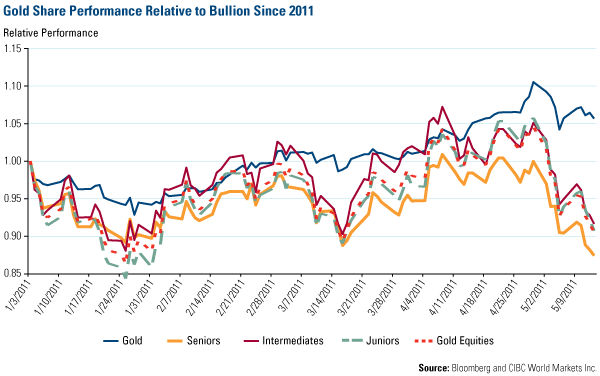
(For the purposes of this chart, CIBC qualifies seniors as companies with market capitalizations above $10 billion, intermediates as those between $10 billion and $2 billion, and juniors as those below $2 billion. Non-producing companies are excluded…)
Gold Share Performance Relative to Bullion Since 2009
Here’s the same chart from above but it has been extended out to the beginning of 2009. You can see that with the exception of the seniors, gold equities have far outpaced gold bullion performance by more than 2-to-1.
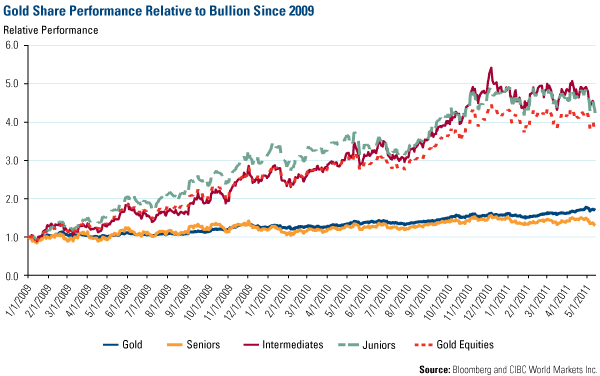
Average Beta-to-Bullion Response for Gold Price Increases
Gold stocks have historically outperformed the price of gold by roughly a 3-to-1 ratio meaning that a 5 percent rise in the price of gold generally translated into a 15 percent rise in the miners but recently this leverage has eroded to about a 1-to-1 ratio, or lower at times…Leverage, of course, can work in both directions, and the beta-to-bullion ratio for many gold stocks is stronger during downward price movements and weaker during the upward ones. This means that the gold stocks are being punished for any downside volatility in gold prices, without being rewarded for any increases [and] this has been unilateral across different market cap sizes.
The chart [below] shows [that] the average beta-to-bullion response for upward movements in the gold price has been declining since 2009. Senior gold stocks have seen the largest decline with their average beta dropping nearly 60 percent.
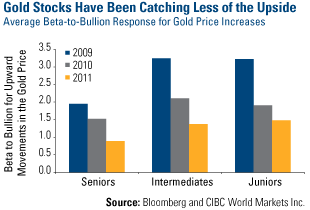
One likely reason for the loss in upward leverage has been the maturation of the gold investing market. In the past, investors looking to gain gold exposure without the headaches of taking physical possession of gold bullion turned to gold equities. Today, the proliferation of bullion-backed ETFs and the birth of small, gold bar buying programs in Asia have unlocked additional options.
Rising Cost of Mining Operations vs. Rising Gold Prices
CIBC’s Barry Cooper…sees this recent phenomenon as “a market-sentiment driven event that will pass as fundamental financial drivers kick in to support share prices and drive them higher” [although] the trend could continue as long as the cost of mining operations continues to inflate. Cooper modeled a case study that showed equities can produce an inferior return relative to bullion when the price of an ounce and the cost to produce it rise in tandem despite the opportunity for companies to use higher prices to expand production or increase reserves.
According to Cooper, “the average global cost per ton has been rising at a rate that is slower than the gold prices increase; however, it has also been accompanied by a declining grade profile for most operations.” The average grade of a gold deposit has declined 21 percent since 2005 but higher bullion prices have made it economically viable for gold companies to pursue higher cost projects and keep lower cost, high grade operations off line in case gold prices pull back.
Further, Cooper says this means that “the market seems to have penalized companies for the rising costs associated with lengthening the life of a mine operation…the market does not seem to be paying for the optionality offered by increasing reserves when they come with increased costs.”
The strongest periods of underperformance seem to correspond with times when cost inflation was high. Cooper concluded that “investors seeking gold exposure also want safety in terms of cost containment, and when part of the reason for buying stocks falters, the choice is abandoned for alternative investments.”
BofA-ML estimates that the average all-in cost for the industry was up 19 percent from the previous year to $1,081 an ounce during the first quarter of 2011. The increase is largely due to rising fuel prices, higher labor costs, increased regulatory expenses and declining ore grades.
While it’s true that these rising costs are putting a strain on miners’ profitability, it’s important to keep it in context. While cash costs have increased 19 percent, profit margins—the true gauge of a company’s value—have expanded 25 percent on average, more than offsetting the cost increases.
Financials for Gold Companies Continue to Improve
In fact, financials for the majority of gold companies have been improving for years. According to Cooper, many gold companies “have been generating positive [cash flow] and growing earnings on a per-share basis.” Although it hasn’t showed up in share price performance, senior gold miners have seen the strongest gains with average per share earnings increasing roughly 67 percent since 2009.
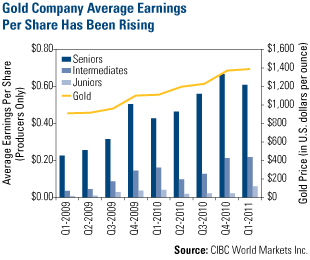
Corporate cash flows for gold producing companies have also increased significantly. The average senior gold miner now has more than twice the amount of cash flow; mid-sized intermediate gold companies’ cash flow has more than tripled.
Gold Mining Stocks Cheap Compared to Price of Gold
This year’s carnage has created a substantial opportunity to buy healthy, gold mining companies at historically low prices compared to gold bullion. Cooper says that “the net result is that gold companies can now be purchased for about their intrinsic value for the spot price of bullion.”
Historically, one could purchase about 4.4. units of the XAU for the price of an ounce of gold. That ratio fell to less than 3 units per ounce in the mid-1990s when gold prices bottomed but has averaged 5.2 units during the current bull market.
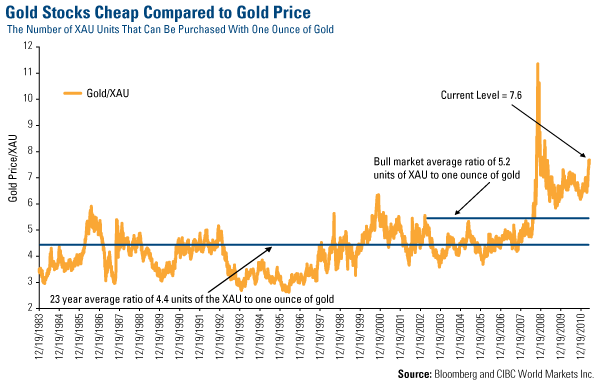
You can see from the chart [above] that today’s level is 46 percent above the historical norm at 7.6 units to one ounce of gold. By this measure, one can purchase shares of gold mining companies at their second-cheapest level in nearly 30 years. The extreme was in 2008 during the depths of the financial crisis; many share values quadrupled off of those levels…
Conclusion
This week’s events in Greece should remind everyone that global markets are still recovering from 2008’s trauma. The system is not nearly as strained as it was then but we are by no means out of the woods in terms of global economic stability. This should continue to provide a catalyst for strong gold prices.
With gold [mining] companies currently undervalued and offering strong cash flows and attractive yields, we think gold equities will be rewarded by the market and rise [disproportionately] with strong gold prices…
*http://www.usfunds.com/investor-resources/investor-alert/
Related articles:
-
Negative Sentiment Suggests Buying Gold & Silver Stocks NOW https://munknee.com/2011/06/negative-sentiment-suggests-buying-gold-silver-stocks-now/
-
NOW is the Best Time to Buy Gold Stocks! Here’s Why https://munknee.com/2011/06/now-is-the-best-time-to-buy-gold-stocks-heres-why/
-
Gold & Silver Warrants Index (GSWI) Update https://munknee.com/2011/06/gold-silver-warrants-index-gswi-update/
-
Buying Gold & Silver Company Warrants is Easy & Profitable – Here’s How (and Why!) https://munknee.com/2011/05/buying-gold-silver-company-warrants-is-easy-profitable-%e2%80%93-here%e2%80%99s-how-and-why/
Editor’s Note:
- The above article consists of reformatted edited excerpts from the original for the sake of brevity, clarity and to ensure a fast and easy read. The author’s views and conclusions are unaltered.
- Permission to reprint in whole or in part is gladly granted, provided full credit is given as per paragraph 2 above.
Gold
 munKNEE.com Your Key to Making Money
munKNEE.com Your Key to Making Money